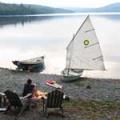The Art of Safeguarding the Shoreline
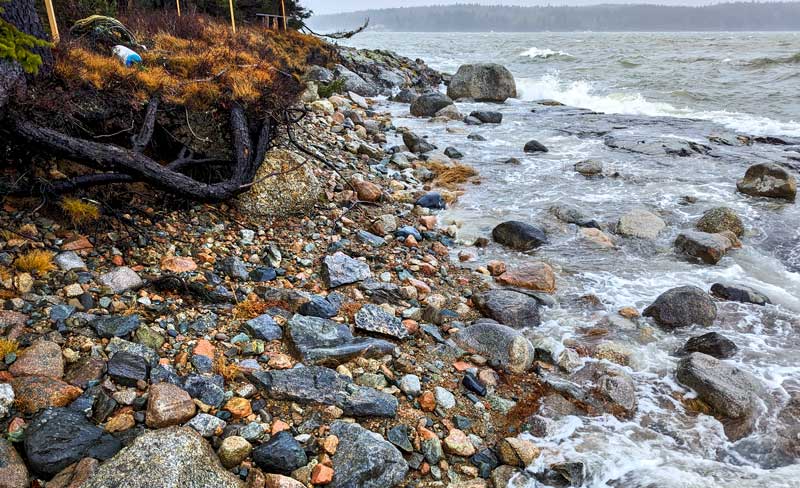 In December, 2023, torrential rains destabilized the point’s sloping shoreline that faces the ocean head-on. Photo by Steve Ribble
In December, 2023, torrential rains destabilized the point’s sloping shoreline that faces the ocean head-on. Photo by Steve Ribble
Jesse Salisbury didn’t focus much on his own stone creations this past year. Instead, the Steuben sculptor’s eyes were trained on Mother Nature’s works wrought by multiple storms that ravaged and dramatically reshaped Maine’s coastline, from Kittery to Lubec.
In the Pine Tree State, Salisbury is known for spearheading the Schoodic International Sculpture Symposium, held from 2007 to 2014 on the Schoodic Peninsula and the University of Maine campus in Orono. Over five summers, sculptors and stone carvers from Sweden, South Korea, Egypt, Japan, and 18 other nations produced 34 public works that form the Maine Sculpture Trail from Ellsworth to Eastport.
Besides staging the symposium, Salisbury has created a diverse body of artwork over 25 years. His often-massive stone sculptures range from Lubec’s “Lost Fishermen’s Memorial,” composed of towering granite waves etched with the names of those lost at sea, to “Beach Pea,” which graces the Portland Jetport, and “Anatomy of a Boulder,” carved from a 20-ton glacial erratic rock, for a private Pennsylvania collector.
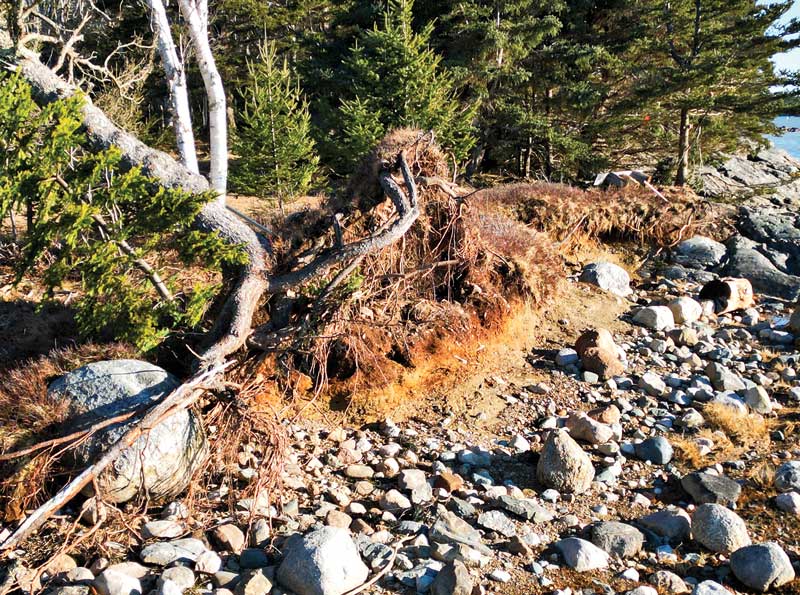 Back-to-back storms in January, 2024, toppled trees, scattered boulders, and further undermined the point of land’s underlying structure. Photo by Steve Ribble
Back-to-back storms in January, 2024, toppled trees, scattered boulders, and further undermined the point of land’s underlying structure. Photo by Steve Ribble
But the sculptor’s knowledge of Maine stone—whether granite or the once-molten basalt—and his carving skill, rock-moving expertise, and artistic sensibility have been applied to other uses since a series of storms blasted the Maine coast in late 2023 and in January of 2024. Blowing from the southeast, hurricane-force winds swept away boats, docks, fishing wharves, and buildings in a number of waterfront towns. Torrential rains and fierce winds, with gusts up to 95 mph, submerged roads and severely eroded the state’s rocky coastline, which helps block storm surges from the Atlantic Ocean.
After mid-December’s washout and the January 10th and 13th storms, Winter Harbor landscape architect Steve Ribble invited Salisbury, who often works alongside his wife, Kazumi Hoshino, to undertake a project to restore a seasonal property’s access to the water and build a stronger sea barrier to shield it from future storm surges.
Hoshino, a Japanese-born artist, works primarily in stone as well. Her creations have been featured in prominent Maine galleries and beyond. Her sculpture “Warm Wind,” a striking, soft-edged piece, graces Washington County’s Roque Bluffs State Park.
Ribble’s Washington County clients, whose cottage faces the ocean head-on, had been in touch with him about reestablishing their access ramp, which had been swept away, and restoring their shoreline. The storms sheared away part of their house’s lawn, uprooted soaring spruces, scattered boulders and rocks, and eroded much of the 140-foot-long shoreline’s sedimentary slope, or bluff, separating it from the beach and sea.
“This series of storms took another three feet horizontally off their property,” the landscape architect recalled. He likened it to a man’s toupée being whipped off in the wind. Bare roots were exposed and trees threatened. “The roots had been stabilizing only a portion of the ground, but years of wave action had eroded the sandy soil. What you had underneath was a big bite out of the soil, creating a very precarious situation.”
His clients, who have asked to remain anonymous, sought to better protect their low-lying point from the advancing Atlantic and destructive stormwaters. In the landscape plan, they wanted to incorporate low-bush blueberries, pepperbush and other native, salt-tolerant plants, and rocks in keeping with the wildly scenic coastal area.
Ribble, whose firm is called Context by Design, said Salisbury had the unique skillset and equipment to do the job. The sculptor also was available at a time when contractors and landscape crews already were swamped with storm-recovery projects.
Describing the landscape work Ribble said, “It needed to look like it belongs here and is in context with the environment. I knew he would have the eye for the correct type of stone and its placement.”
 Sculptor Kazumi Hoshino directs her husband and fellow artist Jesse Salisbury, who is driving the excavator, where to deposit one of the glacial erratic rocks comprising the seaside barrier. Photo by Jesse Salisbury
Sculptor Kazumi Hoshino directs her husband and fellow artist Jesse Salisbury, who is driving the excavator, where to deposit one of the glacial erratic rocks comprising the seaside barrier. Photo by Jesse Salisbury
Planning and Paperwork
Before the landscape plan was drawn up, Ribble took proactive action and contacted the local, state, and federal authorities that regulate Maine’s shoreland zone. The zone encompasses coastline within 250 feet of the normal high-water line. Standards and regulations become more stringent within 75 feet of open water.
The Maine Department of Environmental Protection, federal U.S. Army Corps of Engineers, and the local code enforcement officer all visited the property and commented on the project before an application was submitted for the Maine Department of Environmental Protection’s Natural Resources Protection Act Permit (NRPA), which is required to do shoreland restoration.
“You get everyone involved as early as possible to discover what can and can’t be done and find out what people are going to push back on,” said Ribble, who has practiced landscape architecture for nearly 30 years. His projects have ranged widely from the grounds at Indiana’s LaGrange County Jail and Sheriff’s Office, which features a roofed water trough and hitching post for Amish visitors driving horse-drawn carriages, to Coastal Eye Care’s grounds in Ellsworth, and a private residence’s rebuilt seawall and seaside plantings in the Gouldsboro village of Corea.
Filed last February, the Washington County property owners’ DEP permit application entailed extensive documentation to justify the proposed project, located in the shoreland zone’s more restricted 75-foot setback. The site’s characteristics and notice to neighbors and the public were among other requirements.
Last June, the Maine DEP granted the NRPA permit. The property owners were allowed to repurpose some existing boulders dislodged during the storms along their shore. Rocks, too, are protected, though. “You can’t just pick the beach clean,” Ribble cautioned shorefront homeowners.
Combing through his own fields in Steuben, Salisbury supplied half of the roughly 200 cubic yards of rocks needed to build the new seawall. The rest of the boulders and screened stones came from area contractor Jason Tracey, who delivered them to Salisbury’s workshop. A commercial driver’s license holder, the artist transported the stone to the project site in his 7-yard International dump truck.
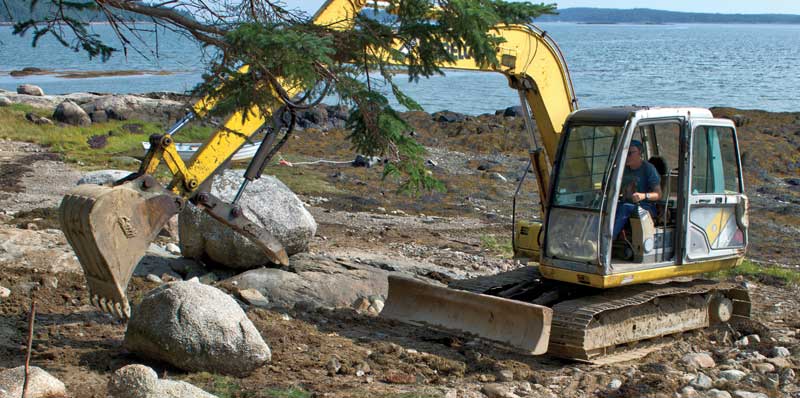 Salisbury used his own excavator to move around existing boulders and glacial erratic rocks that were sourced elsewhere. Photo by Letitia Baldwin
Salisbury used his own excavator to move around existing boulders and glacial erratic rocks that were sourced elsewhere. Photo by Letitia Baldwin
Re-arming the Shore
Last July, Salisbury got to work with his Kolbeco SK 60 excavator at the property, which overlooks a long bay and a wide-open fetch to the Gulf of Maine. The first task was untangling and clearing the downed and uprooted trees, broken branches, and other natural debris. Dead, diseased, and toppled trees could be removed, but tree-felling and pruning are highly restricted in the 75-foot waterfront zone.
To work in the shoreland zone, Salisbury took the Maine DEP’s course certifying him in “Basic & Advanced Erosion Control Practices.” He put those methods to good use on this site. Before building the seawall, he blanketed the 140-foot bank in a layer of Non-Woven Geotextile. The filter fabric retains the soil, yet lets water drain through the stone barrier, and will prevent its structural destabilization over time.
“I really liked the class. I learned quite a bit of technical stuff” the 52-year-old sculptor said of the eight-hour, online course. “There is also a lot of background on Maine geological history as well as information on erosion and sediment.”
Taking a friend’s advice years ago, Salisbury wisely welded a thick steel plate to his single-axle truck’s dump body bed to better withstand loading and hauling large boulders—rocks such as the 7,000-pound slab of lavender granite that now serves as the property’s new access ramp and centerpiece of the barricade buttressing the point.
Fourteen feet long and 4 feet wide, the lavender-hued piece came from the Washington County town of Jonesboro. Overlooking Englishman Bay, the J.C. Stone quarry is known for its light purple granite. Salisbury already had a larger block of it and used a diamond wire saw to horizontally slice a 5-inch-thick slab at his workshop.
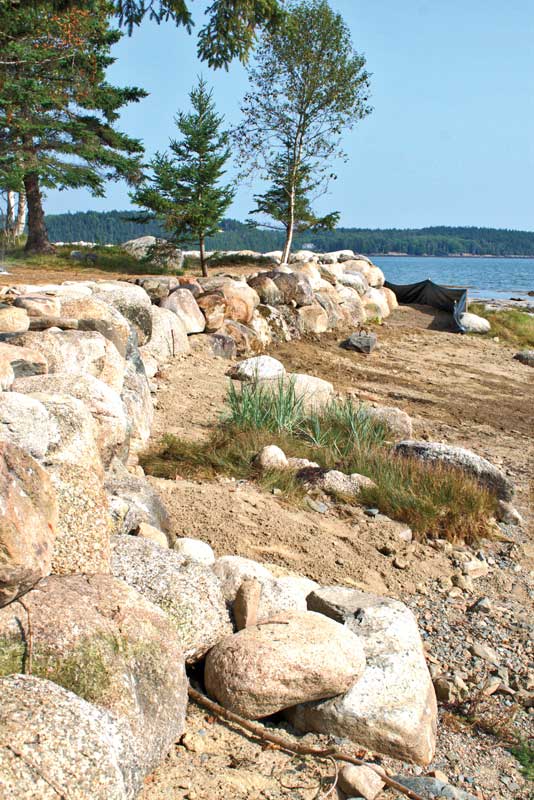 Wild sea lavender and smooth cordgrass are among the native plants growing in the sandy soil among the point’s ledges. Photo by Letitia Baldwin
“It definitely gives it a castle-wall-type feel,” mused Salisbury, surveying the seawall that was completed late last August. Adding the distinctive granite ramp “makes it human interactive because people pass through it or imagine passing through it when they see it.”
Wild sea lavender and smooth cordgrass are among the native plants growing in the sandy soil among the point’s ledges. Photo by Letitia Baldwin
“It definitely gives it a castle-wall-type feel,” mused Salisbury, surveying the seawall that was completed late last August. Adding the distinctive granite ramp “makes it human interactive because people pass through it or imagine passing through it when they see it.”
The family worked as a team. Hoshino lent her own artistic eye and knowledge to the project. As with her own sculptures, Hoshino eyed the seawall’s evolving shape from different angles along the bank and beach. At her direction, Salisbury deftly maneuvered the excavator and deposited the roughly 5,000 square feet of glacial erratics, or rocks, that comprise the barrier, which is 3 to 5 feet in height. The artists’ son, Ren, an award-winning distance runner, also helped out at times.
“We do the wall work with two people. One runs the excavator and moves all the rocks. The other person watches the line from other angles and helps place small rocks behind the larger ones,” Salisbury said. “Because we want quality placement, the large rocks are moved around quite a bit to get the right fit.”
In addition, the seawall has its own invisible backup barrier. Salisbury and Hoshino built another wall of smaller rocks running parallel on the inland side. Topped with soil, the screened drainage stones are encased in Geotextile and further buffer the shoreline.
On a late summer day, the finished seawall of worn, glacially deposited rocks looked like it belonged there. The wall of aged gray, brown, pinkish, and blackened boulders was sturdily built, but lacks the uniform stone color and exact placement common in many rock walls. Each rock has its own character and bears scratches and other marks from its rough journey during the glacial retreat.
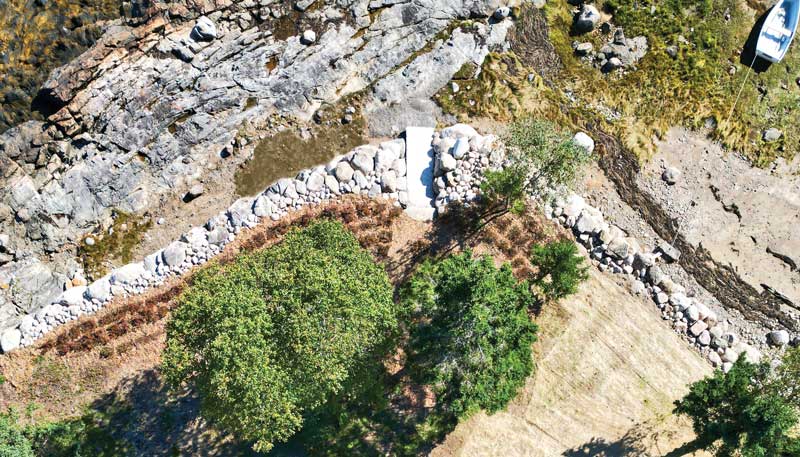 The new seawall is further fortified by a wall of screened stones running parallel on the inland side. Photo by Steve Ribble
The new seawall is further fortified by a wall of screened stones running parallel on the inland side. Photo by Steve Ribble
The barrier also blends in with the smooth cord grass, purple-pinkish heather, and other native plants growing among the lichen-patterned ledges on the beach.
Salisbury approaches seascaping like art.
“It’s like building a sculpture on a really large scale,” he summed up.
✮
Letitia Baldwin is a freelance writer who lives in the downeast towns of Gouldsboro and Cranberry Isles. She previously worked as the Arts & Leisure Editor at The Ellsworth American and style editor at the Bangor Daily News.
To learn more about Jesse Salisbury and Kazumi Hoshino’s work, visit jessesalisbury.com and kazumihoshino.com. Landscape architect Steve Ribble’s work can be seen at contextbydesign.com.
The work of Salisbury and Hoshino was profiled by Carl Little in “Granite Companions” (MBH&H May/June 2018).
Related Articles
Share this article:
2023 Maine Boat & Home Show

Join Us for the Maine Boat & Home Show!
Art, Artisans, Food, Fun & Boats, Boats, Boats
August 11 - 13, 2023 | On the waterfront, Rockland, Maine
Click here to pre-order your tickets.
Show is produced by Maine Boats, Homes & Harbors magazine.










